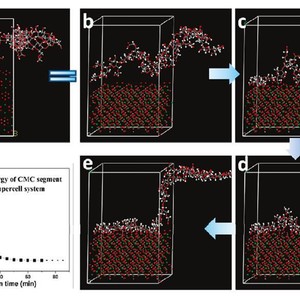Controlling the Morphology of BaCO3 Aggregates by Carboxymethyl Cellulose through Polymer Induced...
Citation
Wei Li, Shengtong Sun, Qisi Yu, and Peiyi Wu*. Controlling the Morphology of BaCO3 Aggregates by Carboxymethyl Cellulose through Polymer Induced Needle-Stacking Self-Assembly. Cryst. Growth Des. 2010, 10, 2685-2692.
Abstract
Inspired by mineralization in biological organisms, fabrication of higher ordered inorganic crystals induced by polymer chains has received much attention. In our present work, we made use of a widely used industrial material, carboxymethyl cellulose (CMC), to mediate the nucleation and growth of barium carbonate (BaCO3). We calculated the interactions between CMC chains and crystalline needle-like units of BaCO3 by molecular dynamic simulation, concluding that the (111) face of crystalline units is the most favorable face for CMC chains to attach onto. Based on the simulation results and the time-resolved experiments, we suggested the dumbbell-like BaCO3aggregates formed via polymer induced stacking of needle-like units. More importantly, we realized control over the morphology of aggregates from dumbbell-like to spherical particles by simply adjusting the polymer concentration. By clarifying the aggregation mechanism mediated by polymer chains, we demonstrate here not only a simple method to fabricate BaCO3 particles with controllable morphologies but also a reference work which may serve the exploration of the mechanism in biomineralization.


